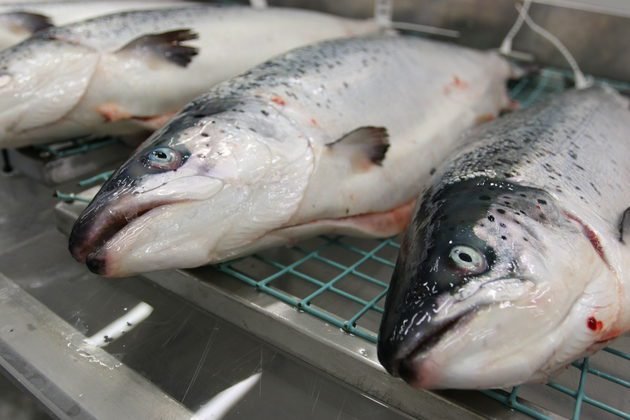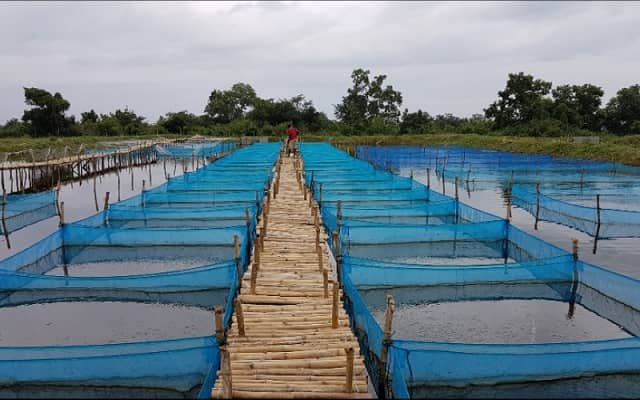
A crucial element in the nutrition of aquaculture species is the long-chain polyunsaturated fatty acids (LC-PUFA) omega-3 (n-3), essential for the health and growth of economically significant fish species like Atlantic salmon (Salmo salar L.).
Traditionally, wild-sourced fish oil has been the primary supplier of n-3 LC-PUFA in aquaculture diets. However, concerns about overfishing and environmental sustainability are driving the search for alternatives.
A new study published by scientists from Dalhousie University and the University of Guelph explores the potential of selective breeding and strain improvement to increase the biosynthesis of n-3 LC-PUFA in Atlantic salmon, reducing dependence on traditional dietary sources.
The Role of n-3 LC-PUFA in Atlantic Salmon
Before delving into strategies to enhance n-3 LC-PUFA production, it is crucial to understand the importance of these fatty acids in Atlantic salmon. N-3 LC-PUFAs, such as eicosapentaenoic acid (EPA) and docosahexaenoic acid (DHA), play vital roles in the physiological functions of salmon, influencing growth, immune response, and overall health.
Post-smolts of Atlantic salmon require between 1% and 1.5% omega-3 in their diet for optimal growth. Fish oil from wild fish is the main source of omega acids used in aquaculture feeds.
EPA and DHA play important roles in the initial development of neural tissue and metabolic regulation in fish. Deficiencies in DHA have been reported to reduce brain and eye development in fish.
Apart from their role in growth and development, omega-3 fatty acids play crucial roles in immune function and steroid biosynthesis in Atlantic salmon.
Challenges and Sustainable Alternatives
Traditionally, fish oil derived from wild populations has been the reference source of n-3 LC-PUFA. However, concerns about overfishing and the environmental impact of this practice have led to the search for more sustainable alternatives.
Stay Always Informed
Join our communities to instantly receive the most important news, reports, and analysis from the aquaculture industry.
Vegetable oils, such as soybean oil and canola oil, have become environmentally and economically viable substitutes. These alternatives aim to provide the necessary n-3 LC-PUFAs without depleting wild fish populations. However, these inputs do not provide high levels of EPA and DHA.
Selective Breeding as a Solution
A promising strategy to enhance the biosynthesis of n-3 LC-PUFA in Atlantic salmon is through selective breeding and strain improvement. Studies have shown genetic influences on the biosynthesis and storage of these essential fatty acids in salmon.
The ability of fish to synthesize n-3 and n-6 LC-PUFA from ALA and LNA is species-specific and depends on gene expression and enzymatic activity.
The study also reports various scientific findings indicating that feeding Atlantic salmon with a low level of fish oil and a high level of vegetable oil increases the relative expression of genes responsible for LC-PUFA synthesis.
In this regard, the scientific review highlights that by selectively breeding individuals with a higher capacity for n-3 LC-PUFA production, it is possible to develop Atlantic salmon lines that are more self-sufficient in meeting their physiological needs.
“In general, the evidence suggests that it may be possible to select salmon for better utilization and synthesis of LC-PUFA, thus allowing better utilization of fish oil-free diets,” the scientists reported.
Scientific Perspectives
Several studies have provided valuable information on genetic factors influencing the biosynthesis and storage of n-3 LC-PUFA in Atlantic salmon. Evidence suggests that through careful selective breeding, it is possible to increase the amounts of EPA and DHA stored in salmon tissues. This approach offers a dual benefit by reducing dependence on external dietary sources, such as fish oil, and improving the nutritional profile of farmed salmon.
Conclusion
“This review described the requirements, functions, and strategies to enhance the supply of n-3 LC-PUFA to Atlantic salmon for optimal health and production,” conclude the scientists.
The review highlights the potential of selective breeding as a sustainable strategy to improve the n-3 LC-PUFA content in Atlantic salmon. By reducing dependence on traditional dietary sources and enhancing the inherent capacity of salmon to produce these essential fatty acids, the salmon industry can contribute to both environmental conservation and the production of healthier, nutrient-rich seafood.
As the world seeks innovative solutions to balance fish demand with environmental sustainability, knowledge in areas such as selective breeding becomes increasingly crucial for the future of aquaculture.
The study was funded by the Discovery Grant from the Natural Sciences and Engineering Research Council of Canada (NSERC) and the Ocean Frontier Institute, through an award from the Canada First Research Excellence Fund.
Contact
Stefanie M. Colombo
Department of Animal Science and Aquaculture
Dalhousie University
Truro, NS, Canada.
Email: scolombo@dal.ca
Reference (open access)
Zhang, Z, Miar, Y, Huyben, D, Colombo, SM. Omega-3 long-chain polyunsaturated fatty acids in Atlantic salmon: Functions, requirements, sources, de novo biosynthesis and selective breeding strategies. Rev Aquac. 2023; 1-12. doi:10.1111/raq.12882
Editor at the digital magazine AquaHoy. He holds a degree in Aquaculture Biology from the National University of Santa (UNS) and a Master’s degree in Science and Innovation Management from the Polytechnic University of Valencia, with postgraduate diplomas in Business Innovation and Innovation Management. He possesses extensive experience in the aquaculture and fisheries sector, having led the Fisheries Innovation Unit of the National Program for Innovation in Fisheries and Aquaculture (PNIPA). He has served as a senior consultant in technology watch, an innovation project formulator and advisor, and a lecturer at UNS. He is a member of the Peruvian College of Biologists and was recognized by the World Aquaculture Society (WAS) in 2016 for his contribution to aquaculture.




